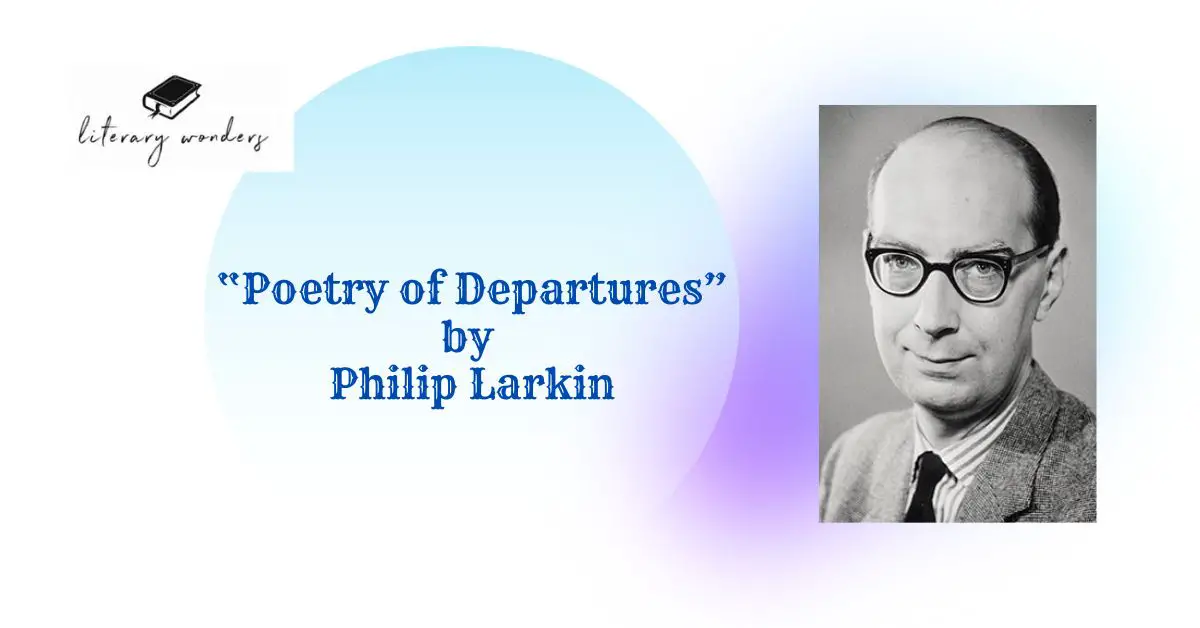“Poetry of Departures” by Philip Larkin

Summary of “Poetry of Departures”
- Popularity of “Poetry of Departures”: The work titled “Poetry of Departures,” authored by the acclaimed English poet and writer Philip Larkin, has garnered significant popularity. This lyrical composition can be characterized as descriptive in nature. The statement, “Poetry of Departures” refers to the inclination towards seeking liberation and the attractiveness of abandoning one’s current existence. The speaker contemplates the notion of an individual forsaking all possessions and embarking on a fresh existence. The speaker finds it attractive due to its representation of an opportunity to liberate himself from the limitations and responsibilities associated with household and routine existence. The poem gained popularity due to its exploration of the themes of escapism and liberation.
- “Poetry of Departures” As A Representative of Sorrow: The poem explores the captivating nature of abandoning one’s current circumstances and embarking on a fresh beginning. The speaker becomes aware of an individual who has made the choice to abandon their current circumstances and depart, which elicits a sense of enthusiasm and motivation inside the speaker. Similar to numerous individuals, the speaker acknowledges his frequent aversion towards their domestic environment and the repetitive nature of their daily existence. The speaker finds the notion of disengaging from the monotony of existence enticing, perceiving it as a transformative and fundamental action. Nevertheless, the speaker also recognizes that abandoning all aspects of his current situation would constitute a conscious regression, and hence, he finally opts not to pursue this course of action. He has the belief that abandoning all prior commitments and embarking on a fresh beginning is an artificial and manufactured approach to establishing a novel existence and being. In the end, the speaker chooses to retain a level of sobriety and diligence, ignoring the allure of ignoring all obligations.
Major Themes in The Poem: The major themes explored in the poem revolve around the innate human inclination towards change, the pursuit of escapism, and the quest for solace. The speaker becomes aware of an individual who has made the decision to embark on a new endeavor or transition in his life. The speaker exhibits signs of envy towards the audacious and transformative action taken by the aforementioned person. The speaker acknowledges their aversion towards their domestic environment and expresses a desire to abandon their current existence. However, he finally goes against this course of action due to a perception that such a departure would result in an artificial and constructed existence. The motif of escape is further elaborated through the utilization of imagery depicting the act of departing from one’s place of residence. Furthermore, the utilization of the metaphor of undressing conveys a profound desire to liberate oneself from the limitations imposed by societal norms and anticipated behaviors. Furthermore, the poem delves into the thematic exploration of the captivating nature of the unfamiliar. The speaker is enticed by the notion of commencing again and wholeheartedly embracing the liberation and excitement that accompanies abandoning all that is known. The poem effectively emphasizes the anguish experienced by individuals who aspire to free themselves from distressing circumstances, yet encounter obstacles preventing their liberation.
Analysis of Literary Devices Used in “Poetry of Departures”
Literary methods are employed to enhance the complexity, intricacy, and diversity of otherwise uncomplicated compositions. In this poem, Philip Larkin has incorporated various literary strategies, enhancing its value as a piece of literature. The present research pertains to the examination of the literary methods employed within the poem.
- Assonance: It refers to the recurrence of vowel sounds within a single line of text, as seen by the repetition of the /e/ sound in the phrase “Sometimes you hear, fifth-hand,” and the repetition of the /o/ sound in the phrase “The good books, the good bed.”
- Anaphora: It is a rhetorical device characterized by the deliberate repeating of a word or phrase at the beginning of successive verses or clauses. In the opening stanza of the poem, Philip used repetition of the word “and” as a rhetorical device to underline the intended message.
“And just cleared off,
And always the voice will sound.”
- Consonance: It refers to the recurrence of consonant sounds within a single line of text, as exemplified by the /h/ sound in the phrase “He walked out on the whole crowd” and the /s/ sound in the phrase “Yes, swagger the nut-strewn roads.”
- Enjambment: It refers to a poetic technique wherein a concept or phrase within a verse does not conclude at the end of a line, but instead carries over to the subsequent line. As an illustration;
“Yes, swagger the nut-strewn roads,
Crouch in the fo’c’sle
Stubbly with goodness, if”
- Imagery: The utilization of imagery in literature serves to evoke sensory perceptions inside readers, engaging their faculties of sight, hearing, touch, taste, and smell. The utilization of imagery is evident in Philip Larkin’s poem, as exemplified by phrases such as “He walked out on the whole crowd,” “Yes, swagger the nut-strewn roads,” and “Leaves me flushed and stirred.”
- Metaphor: The concept of metaphor involves the utilization of a figure of speech wherein an implicit comparison is established between objects that possess dissimilar characteristics. The author used the prolonged metaphor of escape in the poem to illustrate the human inclination to seek relief from a distressing existence, yet find themselves unable to get such respite.
- Symbolism: Symbolism is a literary device that involves the use of symbols to represent abstract concepts and attributes, imbuing them with symbolic significance that extends beyond their literal interpretations. The poem exhibits various symbolic elements, including longing, the need for escape, the allure of the unknown, and a sense of solace.
The analysis reveals that the author has skilfully crafted this little poem into a work of literary excellence through the adept utilization of many literary elements.
Analysis of Poetic Devices Used in “Poetry of Departures”
Poetic devices encompass a range of approaches employed by poets to augment the significance, cadence, and auditory qualities of their literary compositions. The present research pertains to the examination of the poetic devices employed within the poem.
- Diction: The poem exhibits the utilization of descriptive diction, incorporating rhetorical tactics, symbolism, and evocative imagery.
- Free verse: Free Verse is a form of poetry characterized by the absence of regular patterns of rhyme or meter. The present composition is a free verse poem devoid of any rigid adherence to rhyme scheme or metrical pattern.
- Octave: The octave is a stanza consisting of eight lines that originated from Italian poetry. In this context, each stanza exhibits an octaval structure, mirroring the format of the initial and subsequent stanzas.
- Stanza: A stanza is a structural component of poetry consisting of a group of lines. This poem consists of four stanzas, each of which is composed of eight lines.
FAQs about ‘Poetry of Departures’
- What is the poem “Poetry of Departures” about?
The poem explores the captivating notion of abandoning one’s present existence and embarking on a fresh beginning. This statement, “Poetry of Departures” pertains to the inclination towards seeking liberation and the allure of emancipation from the limitations imposed by one’s routine existence.
- Who is the author of the poem?
The poem “Poetry of Departures” is written by Philip Larkin, a renowned English poet and writer.
- Why did “Poetry of Departures” become popular?
The poem gained popularity because it touches on the enduring issue of freedom and escape. It encapsulates the yearning that many people have to give up their present circumstances and welcome brand-new beginnings.
- How does the speaker feel about the idea of leaving everything behind?
The prospect of leaving everything behind initially inspires and excites the speaker. He sees it as an opportunity to escape the routine of everyday life and discover something fundamental and uplifting. Nevertheless, he finally chooses against it since he sees it as a purposeful step backward and a manufactured way to forge a new identity.
- What is the significance of the metaphor of escape in the poem?
The metaphor of escape represents the wish to be liberated from the restrictions and bounds of one’s present life. It stands for the inclination to start over as well as the desire for adventure and the uncharted.
- What is the structure of the poem “Poetry of Departures”?
Since the poem is written in free verse, its rhyme and meter are not predetermined. It has four stanzas with a total of eight lines each. The stanzas use an octave-based rhyme pattern.
- What is the overall message of the poem?
The poem examines how humans naturally want for change and a break from the monotony of everyday existence. It illustrates the conflict between the allure of starting again and the understanding that doing so might not result in true transformation. The speaker ultimately decides to forgo the temptation to flee and instead takes a more responsible and diligent course.
Suggested Readings
“Mad Girl’s Love Song” by Sylvia Plath Analysis

